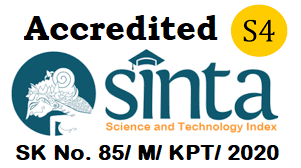Analysis of Welding Operator Work Posture with RULA Method: Case Study in UKM Las XYZ Karanganyar
Abstract
The operator's work posture in production activities is very important to note. Ergonomic work posture will support work productivity. In UKM Las XYZ there are three work postures adopted by the welding operator namely standing bent, sitting on a short chair, and squatting. Welding is the job that causes the highest muscle complaints compared to other jobs in this UKM. The purpose of this study was to assess the risk of work posture adopted by welding operators. The assessment method uses the Rappid User Limb Assessment (RULA) and the Nordic Body Map. The results showed that the final score of the work posture bent has a score of 7, which means that this work posture needs to be investigated and implemented corrective actions. Work postures sitting in short chair and squatting produce a score of 6, which means that this work posture needs further investigation and immediate improvement. Measurement of muscle complaints showed that the part of the body that was experiencing the most pain was back and waist, with an average NBM score of 4 (very sick). This is caused by static or repetitive high frequency work postures adopted by the welding operator.

This work is licensed under a Creative Commons Attribution-NonCommercial-ShareAlike 4.0 International License.












